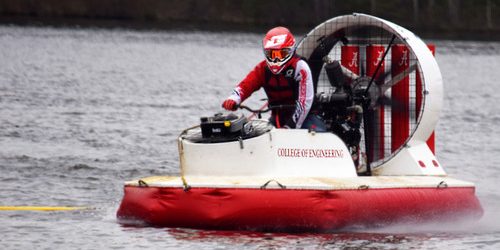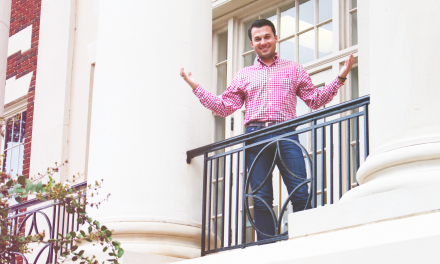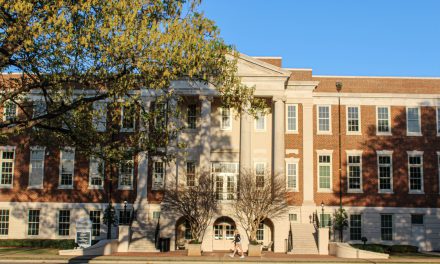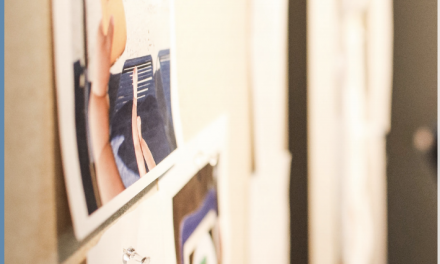
TJ Tritschler tests out his senior project on the water. Hopefully their hovercraft will keep the team’s grades afloat!
The vehicle, powered by a 5-foot-wide propeller in back, was a natural target for a group of third graders visiting the University of Alabama for the College of Engineering’s E-Day. The kids couldn’t know how important this hovercraft was to the aerospace engineers charged with upgrading it. After all, this was something to jump on, to steer from the diver’s seat, and, in general, to use as a jungle gym.
“Careful. Careful. That’s our degree you’re messing with,” said TJ Tritschler, only somewhat jokingly.
Tritschler is one of four students on UA’s Hovercraft Team, now in its fourth year. The group is asked to either build a new hovercraft from scratch or modify and improve existing crafts each year as part of their senior design project.
Not only does the hovercraft matter to their grade point averages, it has to be able to win in competition — but that comes later.
Each aerospace engineering senior at the university must complete a student-led design project, earning three credits in both the fall and spring semesters, in order to graduate. They have four options for their project, but the team believes the shroud of mystery surrounding hovercrafts makes their project different.
“The other [options] are helicopters or RC planes or a rocket — things you typically associate with aerospace,” Tritschler said. “Ours is a hovercraft that doesn’t fly, but you still have to worry about things like aerodynamics with the propeller, so it’s unique.”
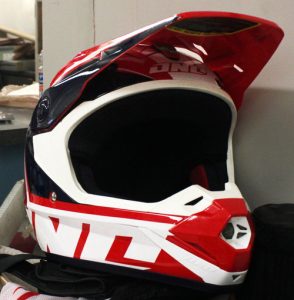
Hovercraft helmets are a typical part of this Aerospace Engineer’s personal effects.
Hovercraft do indeed hover — about half a foot off of the ground to be exact, which allows the amphibious vehicle to travel over almost any flat surface. Trent Isaak, an Honors College student and president of this year’s team, said that an engine in the front of the craft forces air down and fills up the “skirt,” which traps the air beneath the craft with the help of the 5-foot propeller behind the driver’s seat. It works similarly to the fan boats often used in the Everglades, said Alex Simpson, another of the team’s Honors College students.
This year’s team was faced with deciding whether to build a new hovercraft as last year’s team did or to upgrade the two they already had stored in their “hoverlab” in Hardaway Hall.
“We were physically looking around at the space we were given for this project and were like, ‘Where would we even fit it if we built it?’” Simpson said. “We saw we had two race-ready, very capable craft already there, so we [opted] to get them to the point where they’re near perfected.”
Though they are not building a new hovercraft, Simpson is quick to point out that the team is hard at work.
“It’s less major projects, and more smaller projects,” he said. “Where one might not be as time intensive as building a whole one itself, it is a lot of attention to detail. There are two different craft, and they both have different problems. So we’re sort of modeling what was done right on one to do correctly on the other.”
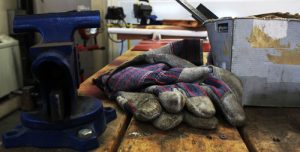
A lot of elbow grease goes into modifying the hovercrafts.
The team will spend their $3,000 budget, mostly grant money and department funding, and an estimated 45 hours to improve both hovercraft this semester in preparation for a final paper and presentation — and their race.
Normally, they compete against Auburn University’s Hovering Tigers. However, due to Auburn’s cancellation this year, the team hopes to simulate a race in order to test their improvements. Isaak said the race track will likely be approximately 40 percent land and 60 percent water, as they had planned, though the official track has not yet been confirmed.
So far, Isaak, who volunteered with last year’s team, has the most driving practice, with 10 minutes behind the wheel. Because the hovercraft isn’t street legal or allowed on UA grounds, the trio said it will have to “race” off campus, perhaps drifting into turns across Lake Tuscaloosa or at the Tuscaloosa Magnet School near campus.
“We can float it, but we can’t actually drive it on campus,” Tritschler said.
Regardless of where their simulated race is held, the team’s drivers — wearing jerseys, motorcycle helmets and life jackets — will test just what their crafts are made of.
“The race is the fun part, so you actually have something to look forward to,” Isaak said.
During their “race,” the driver uses rudders to direct the air and help steer the craft, which Isaak likens to trying to drive an air-hockey puck.
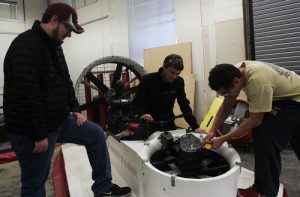
Aerospace Engineers work on the steering controls on the hovercraft.
“You actually have to speed up [to turn] because the thrust is coming from the back, so you need air to go over the rudders,” he said. “You turn with your back, so it’s opposite of what you’d think.”
Although the simulated race is an important component of the course, Simpson said it’s the behind-the-scenes process that matters the most.
“We take it seriously…but it’s much more about how you work the plan that you designed in the fall,” he said. “You’re going to find some snags, and you’re going to have to improv a little bit, but if you start with a good enough plan, you should be right around where you need to be.”

